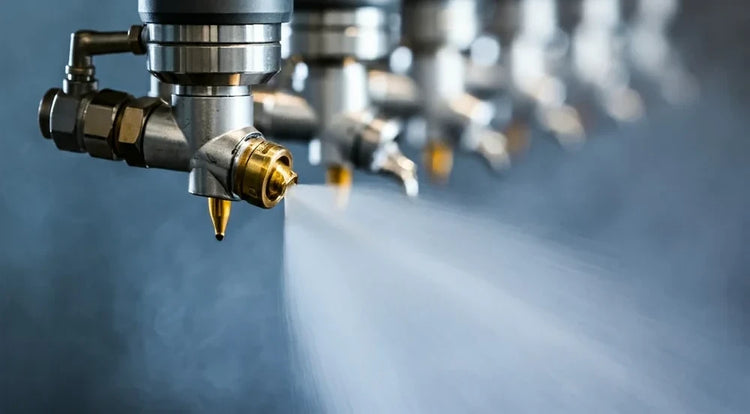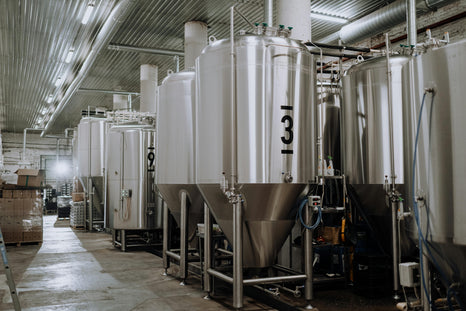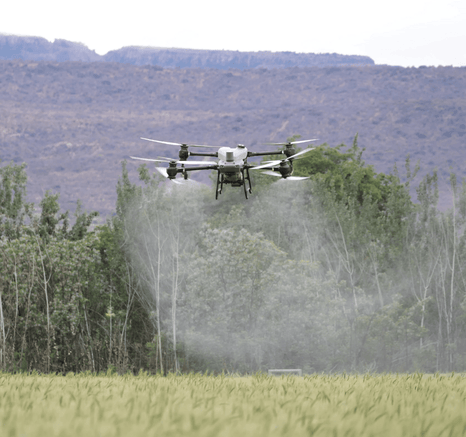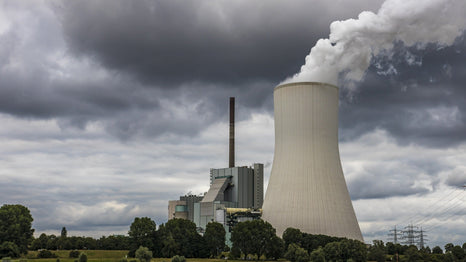Key Takeaways
- Regular maintenance extends nozzle lifespan by 40% or more – switching to appropriate materials and cleaning schedules can dramatically improve performance
- Weekly cleaning is essential for high-pressure applications – neglecting routine maintenance leads to costly downtime and inconsistent spray patterns
- Over-tightening is the most common installation mistake – it causes thread damage and alignment issues that compromise spray quality
- Flow rate changes of 10% or more signal replacement time – monitoring performance metrics helps you replace nozzles before they fail completely
- Material selection matters significantly – upgrading from brass to stainless steel or ceramic can increase durability in harsh conditions
You've spent time choosing the perfect spray nozzles for your industrial system. You've calculated flow rates, selected the right spray angles, and everything's running smoothly. But here's the thing, selecting the right nozzle is only half the battle. Keeping it performing at peak efficiency over time? That's where the real work begins.
Think of spray nozzle maintenance like changing the oil in your car. Sure, you could skip it for a while, but eventually, you'll pay the price in performance problems, unexpected breakdowns, and costly repairs. In industrial settings, neglecting nozzle maintenance can mean production shutdowns, inconsistent product quality, wasted materials, and safety hazards.
The good news? With the right maintenance practices, you can extend nozzle life significantly, optimize system performance, and save serious money in the long run. Let's talk about how.
What Actually Wears Out Your Spray Nozzles?

Before we dive into maintenance strategies, it helps to understand what's actually happening to your nozzles during operation. Industrial spray nozzles face a pretty harsh existence, and several factors contribute to their gradual decline.
Abrasive fluids and high pressure are probably the biggest culprits. When you're pumping fluids containing particles, think sand, metal shavings, or mineral deposits, through a nozzle at high velocity, you're essentially sandblasting the orifice from the inside. Over time, this enlarges the opening, changing your spray pattern and flow rate.
Corrosion and chemical degradation attack nozzles from a different angle. Aggressive chemicals, extreme pH levels, or even just constant water exposure can eat away at nozzle materials. Brass nozzles in particular are vulnerable to dezincification, where the zinc leaches out and leaves behind a porous copper structure that's weak and prone to failure.
Heat damage happens more often than you'd think, especially in high-temperature cleaning applications or cooling systems. Thermal cycling. which is repeated heating and cooling, can cause materials to expand and contract, eventually leading to cracks or deformation.
Clogging is perhaps the most obvious issue. It happens when particulates, mineral buildup, or biological growth block the orifice. But here's the tricky part: partial clogs can be worse than complete blockages because they're harder to detect. Your system keeps running, but with a distorted spray pattern that doesn't do its job properly.
Finally, improper handling during cleaning or installation causes plenty of avoidable damage. Using metal tools to clear a clog can score the precision-machined orifice. Over-tightening during installation, as our team at NozzlePro sees constantly, strips threads and throws alignment off completely.
Combining even two of these factors accelerates wear exponentially rather than additively. A high-pressure system with abrasive fluids in a corrosive environment? That's a worst-case scenario.
How Do You Know When Performance Is Slipping?
Here's the challenge with spray nozzle degradation: it happens gradually. You don't wake up one morning to find your nozzle completely failed. Instead, performance declines bit by bit, and if you're not paying attention, you might not notice until you've got serious problems.
Changes in flow rate are your most reliable early warning sign. If a nozzle that normally flows 5 gallons per minute suddenly measures 5.5 GPM at the same pressure, that's a red flag. The orifice has enlarged due to wear, and your spray characteristics have changed.
Spray angle changes indicate uneven wear. Maybe your 80-degree flat fan nozzle is now producing something closer to 90 degrees on one side and 70 on the other. This asymmetry means you're not getting the coverage you designed for.
Visible signs are important too, though they usually appear after performance has already declined. Look for scoring inside the orifice, buildup around the opening, or discoloration that indicates corrosion. If you're seeing these with the naked eye, imagine what's happening at a microscopic level.
The pros monitor spray patterns systematically. Set up a test panel or use pattern analysis tools to check coverage.
Learn More about Types of Spray Patterns in our Complete Industrial Guide here.
Expert Insight from the NozzlePro Team
We asked our technical team about the most common issues they see in the field, and their answers might surprise you.
"The majority of service calls we get involve clogging, uneven spray patterns, and premature wear from abrasive fluids," explains our lead technician. "But the damage we see most often is actually self-inflicted."
Here's what our team has learned after thousands of service calls:
The biggest maintenance mistake? Over-tightening nozzles during reinstallation. "People think they need to crank down on that high pressure nozzle to prevent leaks," our service manager notes. "But what actually happens is they damage the threads, throw off the alignment, and create the very problems they're trying to prevent."
Our cleaning and replacement schedule recommendation is straightforward: weekly cleaning for high-pressure applications, with full nozzle replacement every 6–12 months depending on your operating conditions and fluid characteristics. That might seem frequent, but the cost of a new nozzle is nothing compared to downtime or quality issues.

One of our favorite success stories involves a client running CIP (Clean-in-Place) systems in food processing. They were replacing brass tank cleaning nozzles every 4–5 months and were frustrated with inconsistent cleaning performance. We recommended switching to stainless steel construction and implementing weekly inspection protocols. The result? Nozzle life increased by approximately 40%, and they saw more consistent cleaning outcomes. The upfront material cost was higher, but the total cost of ownership dropped significantly.
For typical industrial conditions, expect 6–12 months of service life from quality nozzles. But that's assuming proper maintenance and appropriate material selection for your application.
Our recommended inspection toolkit? Keep it simple: visual inspections with magnification (even a basic jeweler's loupe works), regular flow-rate testing, and soft-bristle brushes for cleaning. Never use metal picks or wire brushes. They'll do more damage than the clog you're trying to clear.
Learn how to choose the right high pressure nozzle in our guide here.
Maintenance Best Practices That Actually Work
Let's get practical. Here's how to keep your industrial spray nozzles performing at their best.
Schedule regular inspections. Don't wait for obvious problems. For critical applications, inspect weekly. For less demanding systems, monthly checks might suffice. During inspections, look for changes in spray pattern, measure flow rates, and examine nozzles visually for wear or buildup.
Clean properly. This seems obvious, but technique matters. Remove nozzles carefully, don't force anything. Soak in appropriate solvents for your specific buildup type (mineral deposits need different treatment than organic residue). Use only soft-bristle brushes or ultrasonic cleaning. Metal tools are absolutely off-limits for precision orifices. Rinse thoroughly and inspect before reinstallation.
Filtration is your first line of defense. Installing proper filtration upstream of your nozzles prevents most clogging issues and dramatically reduces abrasive wear. Match your filter mesh size to your smallest nozzle orifice.
Material selection determines longevity. Different spray nozzle types work better with different materials. Brass is economical for mild conditions. Stainless steel offers excellent corrosion resistance and durability for most applications. Ceramic or hardened stainless steel is worth the investment for highly abrasive or high-pressure situations.
Handle with care during installation. Hand-tighten until you feel resistance, then add just a quarter to half turn more with a wrench. Use the correct wrench size and avoid over-torquing. Pay attention to alignment, even slightly crooked installation changes spray patterns and accelerates wear.
Optimizing Performance Beyond Basic Maintenance
Maintenance keeps nozzles working, but optimization makes them work better.
Pressure calibration is critical. Operating at pressures higher than specified accelerates wear and changes spray characteristics. Too low, and you won't achieve proper atomization or coverage. Use pressure gauges right at the nozzle manifold, not just at the pump. Pressure drops through piping can be significant.
Check alignment and orientation regularly. Even properly installed nozzles can shift over time from vibration or thermal cycling. For spray nozzle tips in precise applications like coating or cooling, millimeters matter. Document original settings so you can return to known-good configurations.
Set up quality assurance test patterns. Before committing to a production run, spray onto test panels or use pattern analysis tools. Some facilities are even implementing AI-based visual inspection systems to catch pattern degradation before it affects output. While that sounds high-tech, even simple water-sensitive paper tests can reveal coverage issues you'd otherwise miss.
Monitor flow rates systematically. Keep baseline measurements for every nozzle position in your system. Modern flow monitoring systems can alert you automatically when performance drifts outside acceptable ranges. This predictive approach catches problems early, when solutions are simple and cheap.
Replace or Clean? Making the Right Call

Here's the question everyone asks: when should you clean a nozzle, and when should you just replace it?
Use measurable thresholds. As a general rule, when flow rate increases by 10% or more from baseline at the same pressure, it's replacement time. That means a nozzle designed for 5 GPM that's now flowing 5.5 GPM has worn beyond acceptable limits. The orifice has enlarged enough that you can't restore original performance no matter how thoroughly you clean.
For spray angle changes, if you're seeing more than 5–10% deviation from specifications, replacement is usually the answer. Uneven wear patterns don't improve with cleaning.
Consider the cost-benefit analysis. Yes, high-quality industrial spray nozzles represent an investment. But compare that cost to production downtime, wasted materials, rejected product, or, in extreme cases even safety incidents. In almost every case, planned replacement on a schedule is far cheaper than reactive replacement after failure.
Some nozzles are worth rebuilding. Certain tank cleaning nozzles and large industrial nozzles can be professionally refurbished.
Contact NozzlePro's technical support team to discuss whether rebuild or replacement makes more sense for your specific situation.
Real-World Applications
These principles apply across industries, but let's look at a few specific examples.
In food and beverage processing, sanitation is everything. CIP systems depend on consistent spray coverage to clean tanks, pipes, and equipment. Worn nozzles create dead zones where bacteria can survive, risking contamination and failed inspections. Weekly cleaning and annual replacement schedules aren't luxuries but necessities.
Steel mills and metal processing facilities run cooling systems with industrial spray nozzles operating in incredibly harsh conditions. High temperatures, abrasive scale, and corrosive coolants create a perfect storm for nozzle degradation. These operations often use ceramic or hardened materials and implement strict replacement schedules to maintain consistent cooling across critical processes.
Dust suppression systems in mining, demolition, or material handling need reliable coverage to protect worker health and comply with OSHA standards. Clogged or worn nozzles compromise dust control, creating both safety hazards and regulatory issues. Regular maintenance isn't optional but actually a compliance requirement.
The Bottom Line on Nozzle Maintenance
Here's what it comes down to: proper maintenance extends nozzle life, improves performance, and saves money. It's not complicated, but it does require attention and consistency.
Start with a realistic inspection schedule based on your operating conditions. Clean properly using appropriate techniques and tools. Monitor performance metrics systematically rather than waiting for obvious failures. Choose materials suited to your specific application. And replace proactively based on measurable criteria rather than reactively after problems occur.
The maintenance practices covered here aren't theoretical but proven approaches that our clients use successfully every day. Whether you're running high-pressure washing systems, precision coating applications, or large-scale tank cleaning operations, these principles apply.
Need help evaluating your current maintenance program or selecting more durable nozzles for your application? The NozzlePro team has decades of combined experience across virtually every industrial application.
Contact us for a consultation, or explore our complete product line to find the right nozzles for your specific needs.
Remember: after selecting the right nozzle, ensuring its performance over time is equally critical. A well-maintained spray system is more efficient, more economical, and safer. That's worth a little attention and effort.
FAQs
1. How often should I inspect my industrial spray nozzles?
For high-pressure or critical applications, inspect weekly. Less demanding systems can typically operate with monthly inspections. Always inspect more frequently if you notice any performance changes.
2. What's the fastest way to check if a nozzle needs replacing?
Measure the flow rate at your operating pressure and compare it to baseline measurements. If flow has increased by 10% or more, the orifice has worn beyond acceptable limits and replacement is needed.
3. Can I use any cleaning solution on my spray nozzles?
No, use solvents appropriate for your specific buildup type and compatible with your nozzle material. Harsh chemicals can damage certain materials. Always rinse thoroughly after chemical cleaning.
4. What causes uneven spray patterns even with new nozzles?
Common culprits include improper installation angle, incorrect pressure, partial clogging, or misalignment. Check installation first, then verify operating pressure matches specifications before assuming nozzle defects.











